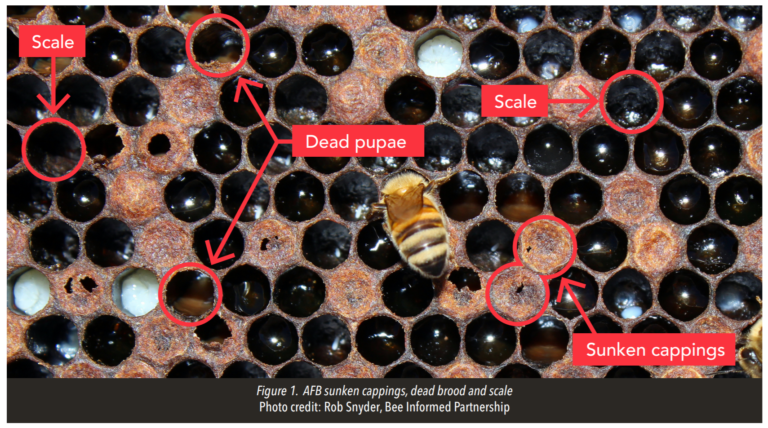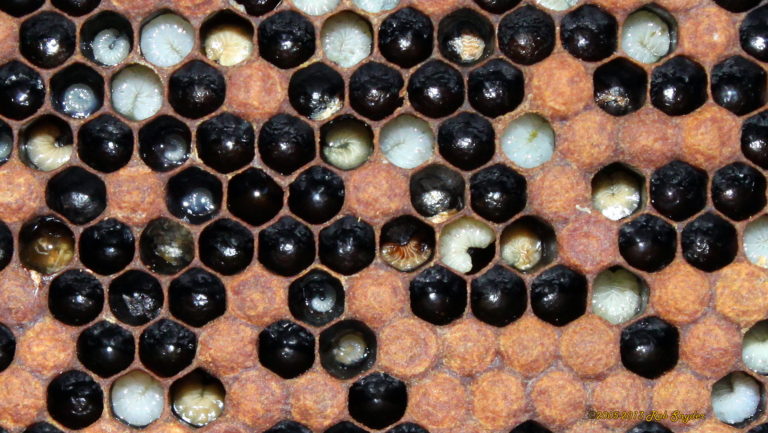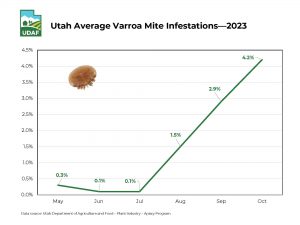Program Contacts:
Kris Watson, Manager, State Entomologist, (801) 982-2311 (office), (801) 982-2313 (lab)
Joey Caputo, State Apiary Inspector, Survey Entomologist, (801) 793-0327 (cell)
Jenna Crowder, State Apiary Inspector, Diagnostic Entomologist, (801) 214-5718 (cell)
The Utah Apiary Program conducts apiary inspections to diagnose pest and disease problems in managed hives. These inspections suppress endemic honey bee maladies and monitor for new, exotic pests. Beekeepers may request an inspection from either a state inspector or a county bee inspector. Some counties do not have a county bee inspector, if you need an inspection in a county without a dedicated inspector please contact a state inspector.
There is no charge for inspections, testing services, or health certification for registered beekeepers.
- Click Here to Schedule with a State Honeybee Inspector or call (801) 982-2313
- Click Here for County Beekeeping Inspectors Contact List
- Click Here to Register as a Beekeeper
- Submit a Sample for Lab Testing
Other Information:
Apiary Rules and Regulations
In 1892, beekeepers successfully lobbied the Utah territorial legislature to pass the first bee inspection act. The legislation was needed to reduce the spread of deadly foulbrood diseases, which had become rampant. Today, beekeepers deal with many new threats in addition to old ones like foulbrood. The Utah Bee Inspection Act is designed to protect Utah’s bees and beekeepers. Below are links to the current version of the Utah Bee Inspection Act and the rules governing it. Contact UDAF for questions about current state regulations.
The Utah Department of Agriculture and Food does not enact nor enforce any city or county beekeeping ordinances. This information has been compiled as a courtesy to the beekeepers and residents of the state. UDAF does not guarantee that this document is up-to-date or comprehensive of all bee-related ordinances in the state. Questions or concerns about compliance with these ordinances should be directed to the local governments which have enacted these rules.
Foulbrood Diseases
INFO FOR VETERINARIANS |
FIND A VETERINARIAN |
VETERINARY FEED DIRECTIVE FAQS |
Foulbrood disease comes in two varieties European Foulbrood (EFB) and American Foulbrood (AFB). While both are rare in the State of Utah, American Foulbrood is of particular concern to beekeepers. Please consult the information provided below and contact UDAF with any questions or concerns you may have.
AMERICAN FOULBROOD
Every beekeeper should be familiar with the signs and symptoms of American foulbrood (AFB). AFB is the most serious of the brood diseases and often results in the death of infected colonies. AFB is highly contagious and can quickly infect many beehives in an area. Please contact UDAF to schedule an inspection if you suspect one of your hives is showing signs of AFB or submit a sample.

American foulbrood (AFB) is not characterized by any single symptom. Pictured above are three of the primary visible symptoms:
- Spotty (inconsistent) brood pattern — As larvae die, a spotty brood pattern forms.
- Black scale — The young larvae are reduced to a blackened scale that is difficult to remove.
- Ropey dead larvae — The dead larvae (that have not yet dried out) rope for an inch or more because the AFB bacteria link together like a chain.
See our fact sheet for a more detailed overview of the symptoms: American Foulbrood Fact Sheet.
AFB TREATMENT
State law requires that AFB infections are managed. Deep burial or burning of infected equipment is the safest and most effective way to control the disease. However, if an infection is caught early, treatment may be a viable option. A bee inspector can help a beekeeper to determine whether infected hives are treatment eligible. If treatment is an option, the beekeeper can contact a veterinarian who will be able to discuss the most appropriate antibiotic treatment.
It is important that robbing is not allowed to occur when a hive is infected with AFB because robber bees may transmit the disease to their colony. If treatment is unsuccessful. deep burial or burning the equipment is the most prudent course of action. Burning is necessary due to the long-lived (40 years) AFB spores that are left behind on exposed equipment.
EUROPEAN FOULBROOD
European foulbrood (EFB) infections are significantly less serious than American foulbrood infections. Healthy colonies are even sometimes able to overcome infections without intervention from the beekeeper. However it is still important that beekeepers be aware of the signs and symptoms so they can handle EFB infections according to their management philosophy. Please contact UDAF to schedule an inspection if you suspect one of your hives is showing signs of EFB or submit a sample.

European foulbrood (EFB) is not characterized by any single symptom. Pictured above are three of the primary visible symptoms:
- Spotty (inconsistent) brood pattern — As larvae die, a spotty brood pattern forms.
- Developing larvae that turn light brown – much like hot cocoa.
- Larvae that die before they have been capped – EFB kills developing bees before they are capped over.
European foulbrood will also cause the dead brood to be ropey and will leave scales. It can be difficult to visually differentiate between American and European foulbrood, which is why lab testing so essential.
EFB TREATMENT
The only treatment for European foulbrood requires beekeepers to contact a veterinarian who will be able to discuss options for appropriate antibiotic treatment. Cultural control methods such as re-queening to break the brood cycle or the shook swarm method may also help clear up mild infections. Thankfully equipment from hives that had European foulbrood does not need to be destroyed. Further information on European foulbrood and how to handle contaminated equipment can be found here.
Varroa Mites
Varroa mites and the diseases they carry represent the single biggest challenge facing honey bees in most areas of the world. In Utah, the vast majority of hive deaths are due to Varroa mite infestations that have been poorly managed. Proper Varroa mite management should be the top priority for beekeepers large and small. It is imperative that beekeepers regularly monitor for this parasite and treat their colonies with an effective Varroacide when mite levels are too high.
UDAF recommends that all beekeepers read the Honey Bee Health Coalition’s “Tools for Varroa Management” guide.
Video on protecting bees from Varroa Mites
MONITORING VARROA MITE POPULATIONS
The first step in effective Varroa mite management is regular measurement of mite loads within colonies. UDAF recommends that beekeepers sample their apiaries for mites at least once a month throughout the beekeeping season. A healthy mite level is no higher than 2% at any point in the beekeeping season; this translates to 3-4 mites per ½ cup of bees measured. If at any point in the season the mite levels are at or higher than 2%, treatment is highly recommended. The following fact sheets are useful resources for monitoring Varroa mite populations.
Varroa Mite Measurement Fact Sheet
As you can see in the graph below, mite infestations in Utah likely become unacceptably high (>2% of the honey bee population) in late summer and peak in October. These excessive infestations are likely major factors in high fall and winter losses. While beekeepers should always be vigilant of mite infestations, managing mites is critical between August through October to ensure that infestations do not become excessive. Colonies are likely to need multiple treatments to control mites during this time period.

TREATMENT OPTIONS
When Varroa mite levels are too high treatment is necessary to prevent colony loss; organic options are available. If you are unsure what treatment is best, consult the decision tool below:
Be sure to read and follow the label on any treatment that you use; it’s the law. Further, improper application may cause a treatment to be ineffective or cause harm to the bees.
Honeybee Health Reports
- 2023 Apiary Program Summary of Accomplishments
- 2022 Apiary Program Summary of Accomplishments
- 2021 Apiary Program Summary of Accomplishments
- 2020 Apiary Program Summary of Accomplishments
- 2019 Apiary Program Summary of Accomplishments
- 2018 Apiary Program Summary of Accomplishments
- 2017 Apiary Program Summary
- 2016 Apiary Program Summary
- 2015 Apiary Program Summary
- 2014 Apiary Program Summary
- 2013 Apiary Program Summary
Africanized Honey Bees
Click here to learn more about Africanized Honey Bees.
Special Districts: Mosquito Abatement Districts, Weed Supervisors and Pesticide Inspectors
- To report a suspected pesticide-related bee kill, contact the pesticide compliance specialist for your district: Pesticide Inspection Districts
- County Weed Supervisors
- Utah Mosquito Abatement Districts
Honey Production
- National Honey Board
- Utah Standard Identity of Honey
- Prepare Honey, including bottling, for Retail - Cottage Food Production
.





